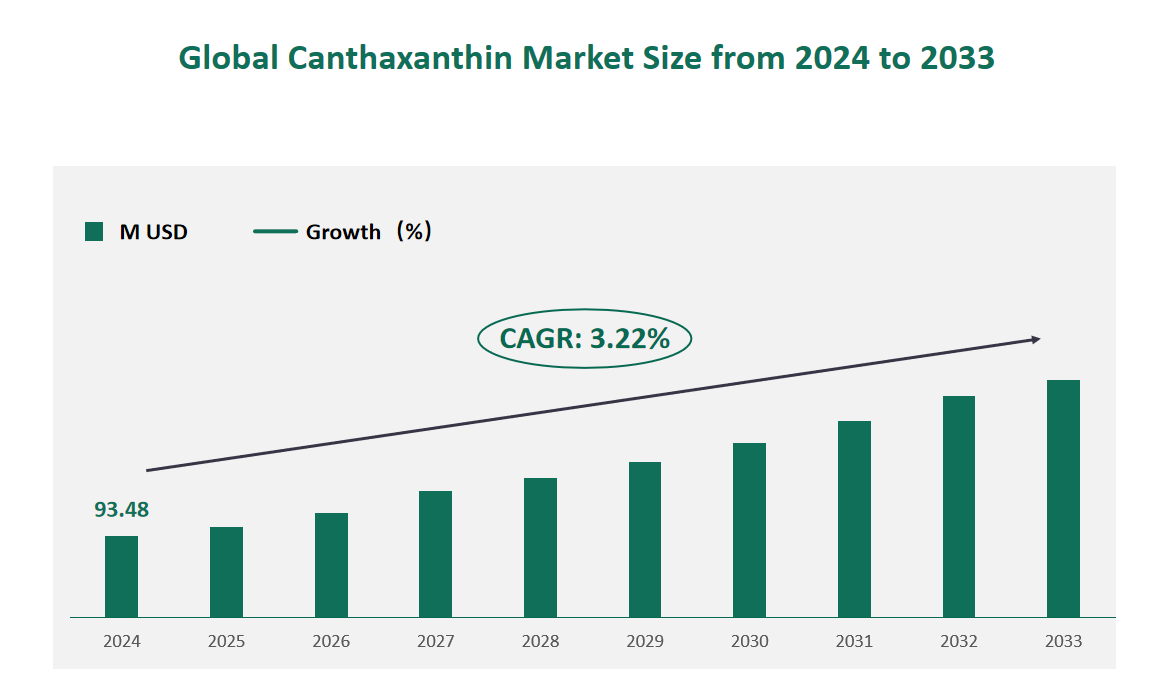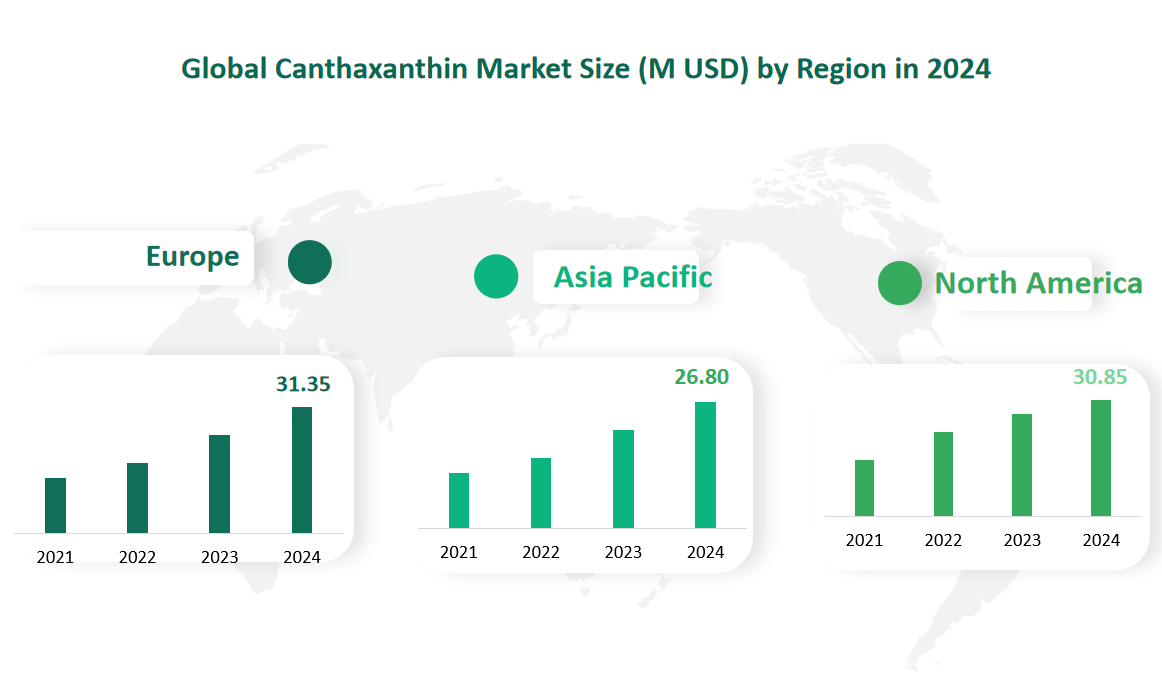1 Global Canthaxanthin Market Size (Value) and CAGR (2024-2033)
In 2024, the global Canthaxanthin market was valued at USD 93.48 million, with a CAGR of 3.22% from 2024 to 2033.
Canthaxanthin is a non-vitamin A-derived keto carotenoid with a characteristic orange-red color. Occurs naturally in many foods such as mushrooms, crustaceans, fish and eggs. Canthaxanthin available on the market is mainly produced by chemical synthesis and is used as colorants in human and animal feed products.
Figure Global Canthaxanthin Market Size (M USD) and CAGR 2024-2033

2 Canthaxanthin Market Drivers
Strengths
Canthaxanthin’s strengths lie in its versatile applications and inherent properties. As a potent antioxidant and colorant, it is widely used across industries such as food, feed, pharmaceuticals, and cosmetics. Its ability to impart a vibrant orange-red color makes it an essential ingredient in various products, enhancing their visual appeal and marketability. The global egg industry, particularly in Asia, has experienced significant growth, driving the demand for Canthaxanthin to achieve a desirable yolk color.
Weaknesses
Despite its strengths, Canthaxanthin faces certain weaknesses. Media attention and changing consumer awareness have led to concerns about its potential health effects. Excessive use of Canthaxanthin has been linked to the deposition of tiny crystals in the human eye, which has garnered negative publicity and led to calls for stricter regulations on its use in aquafeeds. This has affected consumer perception and market acceptance, particularly in regions where regulatory scrutiny is high.
Opportunities
The Canthaxanthin market presents several opportunities for growth and expansion. Emerging markets, especially in Asia-Pacific, offer significant potential due to their large populations, increasing disposable incomes, and growing demand for high-quality food and health products. Technological advancements in production processes, particularly in the extraction of natural Canthaxanthin, could lead to more sustainable and consumer-friendly products. The increasing number of microbial strains capable of producing Canthaxanthin through fermentation also holds promise for expanding natural Canthaxanthin applications.
Threats
The market faces several threats that could hinder its growth. Fluctuations in raw material prices pose a significant risk, as they directly impact production costs and profitability. The global economic downturn and potential macroeconomic instability could reduce demand from downstream industries, affecting the overall market performance. Additionally, the threat of substitutes, such as astaxanthin and other natural pigments, poses a competitive challenge. These alternatives, with similar applications, could capture market share, especially if consumer preferences shift towards more natural or environmentally friendly options.
3 Global Canthaxanthin Market Size and Share by Type in 2024
Synthetic Canthaxanthin is produced through chemical synthesis, a process that involves specific chemical reactions to create the compound from raw materials. This method ensures consistent quality and cost-effectiveness, making it a popular choice for various applications. In 2024, the market size for Synthetic Canthaxanthin is projected to be 57.14 million US dollars. This type is widely used in the food industry to color products such as dairy items, baked goods, and beverages, enhancing their visual appeal. It is also extensively used in the feed industry to color poultry meat, egg yolks, and fish flesh, which is particularly important in the poultry and aquaculture sectors.
Natural Canthaxanthin is derived from natural sources, primarily through the extraction of the compound from specific microorganisms or plants. This type is often preferred by consumers who seek more natural and organic products. In 2024, the market size for Natural Canthaxanthin is projected to be 36.34 million US dollars. Natural Canthaxanthin is used in high-end food products where consumers are willing to pay a premium for natural ingredients. It is particularly popular in organic and health-conscious food markets. In the cosmetics industry, Natural Canthaxanthin is used for its skin-pigmenting properties, targeting consumers who prioritize natural ingredients.
Table Global Canthaxanthin Market Size and Share by Type in 2024
Type | Market Size (M USD) 2024 | Market Share 2024 |
Synthetic Canthaxanthin | 57.14 | 61.13% |
Natural Canthaxanthin | 36.34 | 38.87% |
4 Global Canthaxanthin Market Size and Share by Application in 2024
Feed: The largest application segment, accounting for 37.06 million US dollars. Canthaxanthin is used in animal feed to enhance the color of poultry meat, egg yolks, and fish flesh. This application is crucial in the poultry and aquaculture industries, where a desirable color can significantly impact consumer perception and product marketability.
Food: The second-largest segment, valued at 34.67 million US dollars. Canthaxanthin is used as a colorant in various food products, including dairy items, baked goods, and beverages. Its vibrant orange-red color enhances the visual appeal of these products, making them more attractive to consumers.
Supplements: This segment is valued at 8.86 million US dollars. Canthaxanthin’s antioxidant properties make it a valuable component in dietary supplements, particularly those targeting skin health and overall wellness.
Cosmetics: Valued at 6.56 million US dollars, Canthaxanthin is used in cosmetics for its skin-pigmenting properties. It is particularly popular in products targeting consumers who prioritize natural and organic ingredients.
Table Global Canthaxanthin Market Size and Share by Application in 2024
Application | Market Size (M USD) 2024 | Market Share 2024 |
Supplements | 8.86 | 9.48% |
Food | 34.67 | 37.09% |
Feed | 37.06 | 39.64% |
Cosmetics | 6.56 | 7.02% |
Others | 6.33 | 6.77% |
5 Global Canthaxanthin Market Size by Region in 2024
North America: Valued at 30.85 million US dollars, North America is a significant market for Canthaxanthin. The region’s robust food and pharmaceutical industries drive demand, particularly in the United States and Canada. The market benefits from stringent regulatory standards and a high level of consumer awareness regarding health and wellness products.
Europe: Valued at 31.35 million US dollars, Europe is another key market. The region’s strong food and cosmetic industries, coupled with a preference for natural ingredients, contribute to the demand for Canthaxanthin. Regulatory frameworks in Europe also play a crucial role in shaping market dynamics.
Asia-Pacific: The fastest-growing region, valued at 26.80 million US dollars. The Asia-Pacific market is driven by rapid industrialization, a large population, and increasing disposable incomes. China, Japan, and South Korea are major markets within this region, with significant demand from the food and feed industries.
Figure Global Canthaxanthin Market Size by Region in 2024

7 Major Players in Global Canthaxanthin Market
7.1 Royal DSM N.V.
Company Profile:
Royal DSM N.V. is a global science-based company headquartered in Heerlen, Netherlands. Established in 1902, DSM is renowned for its contributions to health, nutrition, and materials. The company operates worldwide and is divided into segments such as Nutrition, Performance Materials, Innovation Center, and Corporate Activities. DSM’s Nutrition segment includes DSM Nutritional Products and DSM Food Specialties, while its Performance Materials segment consists of DSM Engineering Plastics, DSM Dyneema, and DSM Resins and Functional Materials.
Business Overview:
DSM’s business is characterized by its commitment to sustainability and innovation. The company focuses on providing solutions that enhance the quality of life for consumers globally. DSM’s products are used in a variety of markets, including food and dietary supplements, personal care, feed, medical devices, automotive, paints, electrical and electronics, life protection, alternative energy, and bio-based materials. DSM’s extensive research and development efforts ensure that its products meet the highest standards of quality and efficacy.
Product Profiles:
DSM’s Canthaxanthin product, CAROPHYLL® Red 10%, is a feed additive used primarily for broilers. It provides precise control over skin pigmentation, enhancing the visual appeal of poultry products. This product is highly regarded for its consistency and effectiveness in the feed industry.
Recent Financial Data:
In the most recent year, Royal DSM N.V. reported a revenue of 22.87 million US dollars from Canthaxanthin sales.
7.2 BASF SE
Company Profile:
BASF SE, headquartered in Germany, is one of the world’s leading chemical companies. Established in 1865, BASF operates through six segments: Chemicals, Materials, Industrial Solutions, Surface Technologies, Nutrition & Care, and Agricultural Solutions. The company is known for its diverse product portfolio and commitment to sustainable practices.
Business Overview:
BASF’s business strategy focuses on providing innovative solutions across various industries. The company’s Nutrition & Care segment, which includes Canthaxanthin, is dedicated to enhancing the quality of life through high-quality products. BASF’s extensive research and development efforts ensure that its products meet the highest standards of quality and safety.
Product Profiles:
BASF’s Canthaxanthin product, Lucantin® Red, is a dry powder formulation used as a feed additive. It imparts a red color to egg yolks and broiler skin and is also used in salmonid fish to impart a pink coloration. Lucantin® Red is highly regarded for its stability and effectiveness in various applications.
Recent Financial Data:
In the most recent year, BASF SE reported a revenue of 20.20 million US dollars from Canthaxanthin sales.
7.3 ZMC
Company Profile:
ZMC, headquartered in Zhejiang, China, is a large-scale joint-stock comprehensive pharmaceutical company. Established in 1997, ZMC specializes in the production of fat-soluble vitamins, vitamins, quinolone antibiotics, anti-drug resistant antibiotics, and other products. The company is known for its professional and large-scale production capabilities.
Business Overview:
ZMC’s business strategy focuses on providing high-quality products and solutions across various industries. The company’s leading products include synthetic vitamin E, natural vitamin E, β-carotene, Canthaxanthin, vancomycin hydrochloride, and teicoplanin. ZMC’s commitment to quality and innovation ensures that its products meet the highest standards.
Product Profiles:
ZMC’s Canthaxanthin product, Canthaxanthin Beadlet 10% CWS, is a cold water dispersible beadlet used as a red coloring agent. It is widely used in beverages, soups, sauces, cereals, and confectionery goods. This product is highly regarded for its ease of use and effectiveness in various applications.
Recent Financial Data:
In the most recent year, ZMC reported a revenue of 13.91 million US dollars from Canthaxanthin sales.

